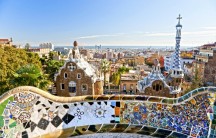While Traveling in Barcelona
Review
- Overall Traveler Satisfaction Rate:
Traveling in Barcelona you can find cuisine from any part of the globe
Barcelona’s food is sporadic in quality, just like all of the greatly touristic locations, however good quality meals really does can be found at affordable prices. The golden rule of thumb can be applied nicely in Barcelona; to lower your expenses and get better food, try to look for places off the beaten track by other tourists and find eating places where the local people frequent. It’s recommended to stay away from dining places with touts outside.
Set menus (menú del dia)
A large amount restaurants (and some bars) offer a menú del dia (menu of the day), which always implies a simple and unpretentious two course lunch or dinner (one salad, main dish and a drink, plus a dessert occasionally), a few choices for each with a beverage and some dessert, for €8 to €15-20, depending on a restaurant. Bear in mind these are definitely not going to be big portions. Normally you will get all of the items listed, but they will be a couple of mouthfuls at most (i.e. all of the food will fit on just one standard sized plate). During the week, certain smart dining places offer lunch specials from 2PM to 4PM. The savvy tourists will try the hip places for a fraction of the price throughout the day.
If you’re trying to find a place where every person may choose their own individual meal, look for restaurants that serve platos combinados, which is the closest thing to an American/Northern European meal.
You can find cuisine from any part of the globe in Barcelona, but you should definitely try certain Catalan food.
Typically announced as Cuina Casolana, based on the purposes of the Mediterranian eating habits: soups, salads, meats, fish and seafood, snails (especially in Lleida during “L’Aplec del Cargol” by early May), desserts (“Crema catalana” or catalan cream, a variant of creme brulée) or “Braç de gitano” which is a long roll made of whipped cream and sponge cake, similar to swiss rolls.
Pa amb tomàquet
Pa amb tomàquet - bread with tomato. Many people in Spain are surprised when discover the Catalan way to prepare “pa amb tomàquet”, because instead of being sliced tomato with bread, the tomato (sometimes with garlic) is squashed and spread in the bread slice, dressed with extra virgin olive oil and small cuts of a very Catalan specialty: cured pork meat, that is, the famous Iberic ham (Spanish for “jamón” and “pernil” in catalan”), “fuet”, “xorís” or “butifarra” (spicy cured sausages), sobrassada, or other stuff like cheese or larger pieces of cooked meat. “Pa amb tomàquet” is a very deeply rooted meal in Catalan houses.
Paella
Paella - typical rice dish from the Catalan Lands. Catalan paella is with seafood, while Valencian paella is without seafood. There’s also a variant of paella which is made up with little noodles called “fideuà”. In addition, paella and fideuà can be prepared with black squid ink, then it’s called “fideuà negra” or “arròs negre” (black fideuà and black rice respectively).
Valencian Paella
On special occasions, 18th century Valencians used paelleras to cook rice in the open air of their orchards near lake Albufera. Water vole meat was one of the main ingredients of early paellas, along with eel and butter beans. Novelist Vicente Blasco Ibáñez described the Valencian custom of eating water voles in Cañas y Barro (1902), a realistic novel about life among the fishermen and peasants near lake Albufera.
Living standards rose with the sociological changes of the late 19th century in Spain, giving rise to gatherings and outings in the countryside. This led to a change in paella’s ingredients as well, using instead rabbit, chicken, duck and sometimes snails. This dish became so popular that in 1840 a local Spanish newspaper first used the word paella to refer to the recipe rather than the pan.
The most widely used, complete ingredient list of this era was as follows: short-grain white rice, chicken, rabbit, snails (optional), duck (optional), butter beans, great northern beans, runner beans, artichoke (a substitute for runner beans in the winter), tomatoes, fresh rosemary, sweet paprika, saffron, garlic (optional), salt, olive oil and water. (Poorer Valencians, however, sometimes used nothing more than snails for meat.) Valencians insist that only these ingredients should go into making modern Valencian paella.
Seafood And Mixed Paella
On the Mediterranean coast, Valencians used seafood instead of meat and beans to make paella. Valencians regard this recipe as authentic as well. In this recipe, the seafood is served in the shell. A variant on this is paella del senyoret which utilizes seafood without shells. Later, however, Spaniards living outside of Valencia combined seafood with meat from land animals and mixed paella was born. This paella is sometimes called “preparación barroca” (barroque preparation) due to the variety of ingredients and its final presentation.
During the 20th century, paella’s popularity spread past Spain’s borders. As other cultures set out to make paella, the dish invariably acquired regional influences. Consequently, paella recipes went from being relatively simple to including a wide variety of seafood, meat, sausage, (even chorizo) vegetables and many different seasonings. However, the most globally popular recipe is seafood paella.
Throughout non-Valencian Spain, mixed paella is very popular. Some restaurants in Spain (and many in the United States) that serve this mixed version, refer to it as Valencian paella. However, Valencians insist only the original two Valencian recipes are authentic. They generally view all others as inferior, not genuine or even grotesque.
Paella de marisco. Photo Attribution: Manuel Martín Vicente. Lic. Creative Commons Attribution 2.0 Generic
Share
Categories
Most Popular




Leave a Reply